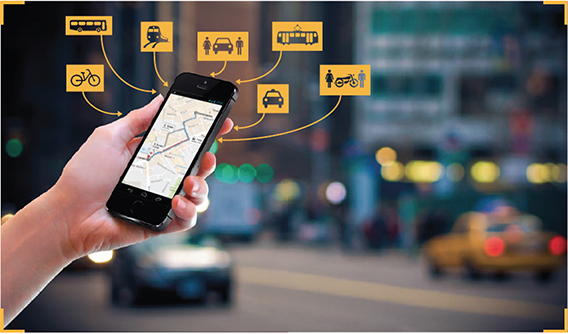
















(In October 2016, the New Cities Foundation published this report as the culmination of the Connected Mobility Initiative, a one-year research fellowship sponsored by the Toyota Mobility Foundation. Below are the first few paragraphs from the Introduction. For the complete report, please click here or on one the links at bottom.)
Introduction
“Cities are always created around whatever the state-of-the-art transportation device is at the time,” Joel Garreau wrote twenty-five years ago in Edge City. At the New Cities Foundation, we are intensely interested in the forces shaping the development of new and old cities alike, whether social, economic, environmental, or technological. The aim of the Connected Mobility Initiative is to explore the triple convergence of “mobility” – physical, digital, and socio-economic – and to propose strategies and steps toward more broadly sharing the benefits of this transformation while ameliorating its potentially corrosive effects on public institutions. In the 1980s and early 1990s, it was the then-cutting edge combination of the personal computer and automobile that spawned the suburban edge cities of Garreau’s title. Today, the state-of-the-art in transportation is the smartphone.
It’s not just that smartphones are ubiquitous, with annual sales approaching 1.5 billion handsets, compared to a total of 1.2 billion motor vehicles on the roads. They’re qualitatively different, doubling as a sensor and pocket supercomputer as well as the focal point of a vast data collection and analysis apparatus churning in the cloud. They’re also the locus of 21st century infrastructure spending, as America’s mobile carriers have collectively invested more than $500 billion upgrading the country’s cellular communications grid – roughly the modern cost of the Interstate Highway System. The smartphone’s ability to choreograph transport has supplanted the importance of any one mode, even the automobile. It will remake the city as surely as previous revolutions did.
The most important questions now are “How?” and “For whom?” The advent of mass-produced Model T Fords a century ago had both spatial and political consequences for cities. Jitneys were banned, streetcars demolished, and mass transit became the public’s domain to eliminate competition with burgeoning automakers. Federal funds were marshaled to build freeways and finance suburbia. Meanwhile, systematic disinvestment hollowed out cities, requiring decades to repair and recover. Nearly thirty years passed between the judgment famously (though falsely) attributed to British Prime Minister Margaret Thatcher that, “a man who, beyond the age of 26, finds himself on a bus can count himself as a failure,” and Bogota Mayor Enrique Penalosa’s more recent assertion that “an advanced city is not one where even the poor use cars, but rather one where even the rich use public transport.”
How will we speak of connected mobility thirty years from now? As an enhancement of Penalosa’s city, or as the moment public transport willingly began to dismantle itself in the face of smartphone-led disruption? It is critical for policymakers to understand that new technologies and services such as Uber, Waze, and autonomous vehicles are not neutral. They embody values and business models that, left unchecked, may run counter to the goals of creating livable and equitable cities – whether intentionally or unintentionally. It’s imperative for transit agencies, public officials and their partners to understand the implications of this shift and to reposition themselves as the stewards of a broader, more flexible networked transportation system.
CLICK ON ONE OF THE LINKS BELOW FOR THE FULL REPORT:

» Folllow me on Twitter.
» Email me.
» See upcoming events.

Greg Lindsay is a generalist, urbanist, futurist, and speaker. He is a non-resident senior fellow of the Arizona State University Threatcasting Lab, a non-resident senior fellow of MIT’s Future Urban Collectives Lab, and a non-resident senior fellow of the Atlantic Council’s Scowcroft Strategy Initiative. He was the founding chief communications officer of Climate Alpha and remains a senior advisor. Previously, he was an urban tech fellow at Cornell Tech’s Jacobs Institute, where he explored the implications of AI and augmented reality at urban scale.

----- | January 22, 2024
The Future of Generative AI in Architecture, Engineering, and Construction
----- | January 1, 2024
----- | August 3, 2023
CityLab | June 12, 2023
Augmented Reality Is Coming for Cities
CityLab | April 25, 2023
The Line Is Blurring Between Remote Workers and Tourists
CityLab | December 7, 2021
The Dark Side of 15-Minute Grocery Delivery
Fast Company | June 2021
Why the Great Lakes need to be the center of our climate strategy
Fast Company | March 2020
How to design a smart city that’s built on empowerment–not corporate surveillance
URBAN-X | December 2019
CityLab | December 10, 2018
The State of Play: Connected Mobility in San Francisco, Boston, and Detroit
Harvard Business Review | September 24, 2018
Why Companies Are Creating Their Own Coworking Spaces
CityLab | July 2018
The State of Play: Connected Mobility + U.S. Cities
Medium | May 1, 2017
Fast Company | January 19, 2017
The Collaboration Software That’s Rejuvenating The Young Global Leaders Of Davos
The Guardian | January 13, 2017
What If Uber Kills Public Transport Instead of Cars
Backchannel | January 4, 2017
The Office of the Future Is… an Office
New Cities Foundation | October 2016
Now Arriving: A Connected Mobility Roadmap for Public Transport
Inc. | October 2016
Why Every Business Should Start in a Co-Working Space
Popular Mechanics | May 11, 2016
Can the World’s Worst Traffic Problem Be Solved?
The New Republic | January/February 2016

January 31, 2024
Unfrozen: Domo Arigatou, “Mike 2.0”
January 22, 2024
The Future of Generative AI in Architecture, Engineering, and Construction
January 18, 2024
The Promise and Perils of the Augmented City
January 13, 2024